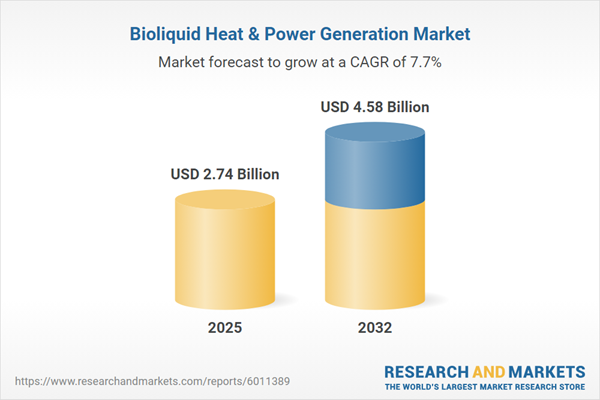Speak directly to the analyst to clarify any post sales queries you may have.
The global bioliquid heat and power generation market presents a compelling pathway for organizations seeking sustainable, efficient energy solutions. This report delivers a clear overview of how innovative technologies, evolving policy frameworks, and diversified project models create substantial growth and investment opportunities for senior decision-makers.
Market Snapshot: Bioliquid Heat and Power Generation
The Bioliquid Heat & Power Generation Market grew from USD 2.54 billion in 2024 to USD 2.74 billion in 2025. It is expected to continue growing at a CAGR of 7.65%, reaching USD 4.58 billion by 2032. This strong momentum is driven by net-zero targets, advancements in feedstock utilization, and increased demand for decentralized, low-carbon energy sources.
Scope & Segmentation of the Bioliquid Heat and Power Generation Market
This research offers a comprehensive examination of the market’s core segments, technology adoption, and geographic reach:
- Technology: Co-firing, combustion, gasification, and pyrolysis address varied operational requirements and infrastructure constraints, offering flexibility in deployment.
- Capacity Range: Solutions span below 1 megawatt for remote or niche uses, 1 to 5 megawatts for modular and scalable applications, and above 5 megawatts for utility-scale or centralized operations.
- Feedstock: Agricultural residues, energy crops, industrial organic waste, municipal organic waste, and wood pellets ensure a diverse supply chain and influence both cost efficiency and sustainability.
- Application: Target sectors include combined heat and power, heat only, and power only setups, reflecting the broad applicability of bioliquid assets.
- End Use: Commercial, industrial, residential, and utilities each present distinct operational drivers and procurement strategies.
- Geographies: Americas (including North and Latin America), Europe, Middle East & Africa, and Asia-Pacific, with in-depth analysis of activity in countries like the United States, Germany, India, China, and Brazil.
- Key Players: Companies such as Archer Daniels Midland, Cargill, BP PLC, and BTG Bioliquids shape the competitive landscape through innovation, vertical integration, and strategic financing.
Key Takeaways for Senior Energy Decision-Makers
- Modular and scalable bioliquid solutions align with the rapid transition toward decentralized energy models and can complement intermittent renewables.
- Strategic partnerships between feedstock providers and technology suppliers enhance security of supply, support integrated value chains, and reduce volatility in project inputs.
- Emerging policy instruments, including carbon pricing and renewable heat obligations, are influencing deployment strategies and project economics in multiple regions.
- The integration of digital monitoring, predictive maintenance, and real-time optimization improves reliability and overall asset performance throughout a site's operational life.
- New financing approaches, such as green bonds and performance-based contracts, are unlocking capital for both pilot and commercial-scale developments.
- Regional markets display unique adoption drivers: policy in Europe supports advanced deployments; North America leverages robust feedstock supply; Asia-Pacific accelerates industrial installations in response to growing demand.
Tariff Impact on the North American Market
Upcoming United States tariff schedules for 2025 pose both hurdles and incentives. Higher import duties may raise capital expenditures for plant construction and retrofits. However, these measures are prompting domestic equipment manufacturers to invest in new capacity, fostering cost reductions, supply chain resilience, and greater local innovation over time. Stakeholders are reconsidering procurement and forming new joint ventures to adapt to the shifting tariff landscape.
Methodology & Data Sources
This report relies on robust primary and secondary data. Insights come from direct interviews with industry experts, combined with analysis of academic papers, association reports, and regulatory documents. All findings are validated through cross-comparison of independent sources and are refined in stakeholder workshops for consensus and accuracy.
Why This Report Matters for Your Organization
- Get actionable intelligence on the best-fit technologies and project models to accelerate your sustainable energy transition.
- Identify strategic opportunities in key market segments and regions to support competitive positioning and long-term investment planning.
Conclusion
This report equips leaders with the strategic, technical, and market intelligence necessary to prioritize investments across the bioliquid heat and power generation landscape. Accelerate your organization’s decarbonization initiatives and optimize energy portfolios with integrated, data-driven decision support.
Additional Product Information:
- Purchase of this report includes 1 year online access with quarterly updates.
- This report can be updated on request. Please contact our Customer Experience team using the Ask a Question widget on our website.
Table of Contents
3. Executive Summary
4. Market Overview
7. Cumulative Impact of Artificial Intelligence 2025
Companies Mentioned
The companies profiled in this Bioliquid Heat & Power Generation market report include:- Altret Greenfuels Limited
- Archer Daniels Midland Company
- Argent Energy
- Biomass Technology Group
- BP PLC
- BTG Bioliquids B.V.
- Cargill, Incorporated
- Encontech B.V.
- Enerkem Inc.
- Ensyn Technologies Inc.
- REG Power Management
- Washwell Group
Table Information
| Report Attribute | Details |
|---|---|
| No. of Pages | 182 |
| Published | November 2025 |
| Forecast Period | 2025 - 2032 |
| Estimated Market Value ( USD | $ 2.74 Billion |
| Forecasted Market Value ( USD | $ 4.58 Billion |
| Compound Annual Growth Rate | 7.6% |
| Regions Covered | Global |
| No. of Companies Mentioned | 13 |









